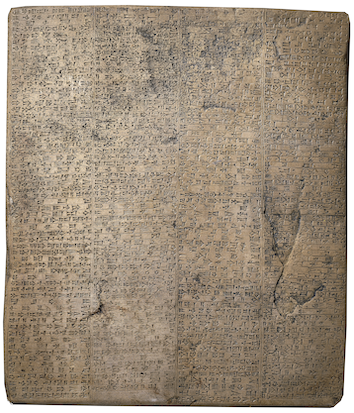Edimana (temple of Sîn at Borsippa)
According to two Akkadian inscriptions of the Neo-Babylonian king Nebuchadnezzar II (r. 604–562 BC), there was a temple dedicated to the moon-god Sîn at Borsippa. Edimana, according to one of those texts was inside the Ezida temple complex.

BM 129397, a large stone tablet that bears a long Akkadian inscription that is now commonly referred to as the "East India House Inscription." The description of Nebuchadnezzar's rebuilding of Edimana is recorded in lines iv 61–65. Image adapted from the British Museum Collection website. Credit: Trustees of the British Museum.
Names and Spellings
This temple at Borsippa went by the Sumerian ceremonial name Edimana, which means "House, Bond of Heaven"; that name is also attested for a sanctuary of Sîn at Ur.
- Written Forms: e₂-dim-an-na.
Known Builders
- Neo-Babylonian (ca. 625–539 BC)
- Nebuchadnezzar II (r. 604–562 BC)
Building History
Nebuchadnezzar II, the son of Nabopolassar (r. 625–605 BC), sponsored many building activities at Borsippa. The rebuilding of Edimana was one of the temples in that city that this Neo-Babylonian king claims to have rebuilt. A text written on a large stone tablet, the so-called "East India House Inscription," records that this temple of the moon-god was located within Ezida's enclosure wall. In another inscription, Nebuchadnezzar states that he rebuilt Edimana (exactly) as it had been in the past. No further details are provided.
Archaeological Remains
Edimana has not yet been positively identified in the archaeological record.
Further Reading
- George, A.R. 1993. House Most High. The Temples of Ancient Mesopotamia (Mesopotamian Civilizations 5), Winona Lake, p. 75 no. 160.
Jamie Novotny
Jamie Novotny, 'Edimana (temple of Sîn at Borsippa)', Babylonian Temples and Monumental Architecture online (BTMAo), The BTMAo Project, a sub-project of MOCCI, [http://oracc.org/btmao/Borsippa/TemplesandZiggurat/Edimana/]